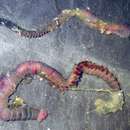Biology
provided by Arkive
This lugworm lives in burrows in the sediment at depths of 20-40cm (3). It feeds on organic matter in the sediment by drawing water into the burrow and filtering particles from the current (2).
The sexes are separate, and spawning typically occurs in late autumn and winter (3). Males release sperm, which rests in puddles on the sediment surface before being dispersed by the tide (2). Females release eggs into the burrow, where they are fertilised by sperm that is drawn into the burrow with the respiratory current (2). Initially, the larvae develop inside the burrow, they then crawl or swim to the sediment surface where they are dispersed by currents (2). The larvae settle on areas of sand or shingle and live inside mucus tubes attached to the sediment; after a few months these tubes detach, and the young worms drift in the water for a time before burrowing into the sediment (2). Sexual maturity is reached after around 2 years, and spawning occurs once a year. The average life-span of this worm is thought to be around 6 years (2). Although they are relatively safe within their burrows, this species is vulnerable to predation by flatfishes and birds, who crop the tail region of the worm as it deposits casts; the worm usually survives, although the growth rate may subsequently decrease (3).
Conservation
provided by Arkive
No conservation action has been targeted at this species.
Description
provided by Arkive
The presence of this lugworm can be detected by the characteristic signs of one of its U or J-shaped burrows; depressions are formed at the head-end, and a cast of coiled defecated sediment is present at the tail-end (3). This segmented worm has a cylindrical body, which has two distinct regions; the thoracic region bears bristles (known as 'chaetae'), and the last 13 segments also have bushy gills (3). The abdominal region (the tail end), which is thinner than the thoracic region, lacks gills and bristles. The colour of this worm varies greatly; it may be pink, red, brown, black or green (3).
Habitat
provided by Arkive
Found on the middle and lower shore, in sand and muddy sand (2).
Range
provided by Arkive
Common around all coasts of Britain and Ireland. Elsewhere it is known from western Europe, Norway, Iceland, Siberia, Greenland and on the coasts of the western Atlantic (3).
Status
provided by Arkive
Common and widespread (2)
Threats
provided by Arkive
Lugworms provide an important source of food for many species of wading shore birds including the oystercatcher (Haematopus ostralegus) and curlew (Numenius arquata). They are also collected commercially for use as bait in angling (3).

